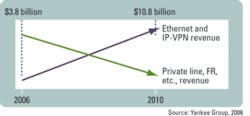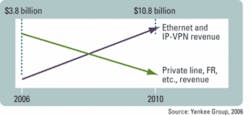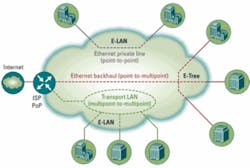Metro Ethernet over GPON enhances business services
by Eric Doricko
Overview
As Ethernet networks become more popular, the combination of GPON and services based on Metro Ethernet Forum specifications can significantly improve carriers' business models.
The reign of the dedicated T1 line into businesses is slowly fading away, replaced by the superior capacity and flexibility of new Ethernet technologies that can now provide comparable reliability. At the same time, new high-capacity transport vehicles like GPON have also come to market that enable significantly more bandwidth and lower operational costs than traditional network approaches.
Service providers are finding that by combining GPON delivery with high-bandwidth Metro Ethernet business services they can radically enhance the options available to their business customers and deliver these services much more efficiently at the same time. To thoroughly understand the opportunity and how it is defining the new frontier for business services delivery, we need to look at how service providers have traditionally addressed business service requirements.
Communications service providers have traditionally built network infrastructures to meet the high-availability requirements of their largest enterprise customers. The result was a variety of highly available TDM infrastructures, built on resilient technologies such as SONET/SDH for deterministic, 50-msec physical-ring recovery.ATM was soon deemed the new carrier-grade standard multiservice protocol that would ride on top of these protected rings to provide a consolidated network infrastructure. ATM also was perceived as meeting the demands of multiple service-delivery methodologies. This combination of ATM and SONET/SDH also enabled service-performance guarantees, allowing voice and time-sensitive applications to ride alongside bursty data applications.
Of course hindsight is 20/20, but relative to today's options, these protocols were highly complex and expensive and made for very rigid service provisioning models. That said, they did meet the business requirements of the day�high reliability, with working protection against fiber cuts and equipment failures. Networks began to evolve, however, and this infrastructure proved to be very inflexible, not scalable, and unable to adapt to burgeoning IP bandwidth requirements and evolving service models.
This requirement evolution derived from the boom in personal computers, work-group file servers like Novell IPX/SPX, and an array of client-server technologies that sprang up virtually overnight in enterprises. As these network protocols and devices flooded the market, the industry began to consolidate to pure IP applications. The demand on LANs multiplied, driving out legacy token ring, Appletalk, and FDDI technologies, which were replaced by ubiquitous Ethernet LANs. Corporations also started to run critical applications over Internet-based virtual private networks (VPNs) and private IP networks. Although Frame Relay, T1s, and ATM provided some of the virtual WAN connectivity with data-bursting capabilities, they were quickly overrun by IP applications needing more bandwidth (see Fig. 1).
Hence, the sea change to Ethernet technologies spread throughout the mass market and eventually into the WAN interfaces at the customers' premises. It wasn't long before Ethernet ports gained acceptance as the standard data WAN port for IP applications. Providers still offered TDM ports, but they were more focused on secure voice and legacy applications like SNA. These WAN Ethernet ports were first deployed via a managed router service; the branch office router would have a T1 or Frame Relay port facing the network and an Ethernet port facing the customer.
Adoption rates in the enterprise were extremely high, and Ethernet became the standard “smart jack” for connection to any network-based application on the LAN. Ethernet devices proliferated, driving sales of network interface cards, communications equipment, and even Wi-Fi Ethernet protocols. Ethernet proved to deliver very reliable and interoperable connectivity for Layers 1, 2, and 3â��driven by earlier efforts defined in the IEEE and IETF standards bodies. In turn, Ethernet has driven wide-scale interoperability from the edge of the network through to the network core.As this industry boom continued, eventually Carrier Ethernet was born, branded first as a “Metropolitan Ethernet” technique used by competitive access providers (CAPs) like Yipes. The CAPs would dedicate pairs of fiber around a metropolitan area in a ring. From this ring, point-to-point switched Ethernet connections went from their switching centers and central offices (COs) to their business customers, and an edge device terminated the fiber.
However, the economics of a dedicated pair of fibers to deliver optical Ethernet services to a single customer proved to be unfeasible, except when connecting to very large enterprises or ISP bandwidth wholesalers. An additional problem with the dedicated fiber approach was that there were many more small and medium business prospects than large prospects within a metro area, and they demanded far below a Gigabit Ethernet rate at each location. This is where GPON and passive-splitter fiber technologies entered the business market.
GPON, driven as a standard by the Full Service Access Network (FSAN) group and ratified by the ITU, has quickly become the dominant fiber protocol in FTTP deployments in most parts of the globe. Directly addressing the network and cost challenges wide fiber proliferation poses, GPON enables the creation of an all-optical multiservice network with the ability to tap into a single strand of fiber in the CO.
In a GPON, an optical line terminal (OLT) blade deployed at the CO drives a signal across a single fiber strand that reaches up to 33 km into the serving footprint. Anywhere along the path of this fiber, a passive (unpowered) splitter breaks the fiber strand into 4, 8, 16, 32, or 64 ports, each connecting to an optical drop fiber. Each drop fiber from the splitter terminates at the outside of the business on an optical network terminal (ONT). All of the devices in this optical distribution network employ a single strand of fiber with a simplex transceiver.
These ONTs enable transmission of a variety of services natively over a unique wavelength on the PON. For example, RF signals and RF return each have unique places on the light spectrum across the fiber, just as upstream and downstream bandwidth for data each have unique wavelengths. An additional benefit of GPON is the disruptive economic model and capital expenditure savings it enables, typically averaging one-tenth the cost of an MPLS switched Ethernet approach using pseudowires.
As service demands and economics push the mass-market shift toward higher bandwidth and cost efficiency, the Metro Ethernet Forum (MEF) has stepped in to define standards-based service models. The charter of the MEF is to promote the worldwide adoption of Carrier Ethernet, but much of its recent work has focused on simplified Layer 2 network and service delivery models for the operators and their enterprise customers.
These MEF service models have been driven to date by service providers and in part by their enterprise customers' desire for a simplified service offering for their site-to-site WANs. This enterprise service movement represents a great opportunity for network service providers, with yearly global recurring revenue reaching more than $30 billion by 2012, according to Vertical Systems Group.
The MEF has defined a number of models and service definitions built around existing standardized Layer 2 service delivery models (see Fig. 2). The equipment employs simple, innovative VLAN switching technologies. Some of the most common services resulting from the MEF's work include Ethernet private lines (E-Lines), Ethernet transparent LANs (E-LANs), and corporate branch-office connectivity via a secure tree technology (E-Trees). Each of these topologies is driven by the MEF 9 suite of test cases, using basic secure VLAN tag switching, which maps the customer's Ethernet port across the cloud via an Ethernet virtual circuit (EVC).
Additionally, the MEF has defined attributes of the operator's Ethernet interface to the customer as the user network interface (UNI) port. Different service models at the UNI yield different definitions of how the traffic from the customer will be forwarded and filtered through the network cloud. The end-to-end behavior of these services and traffic management on the EVC connections are detailed by MEF 14 test cases. MEF 14 certification ensures that when service multiplexing and different applications ride the same UNI ports, each can have quality of service (QoS) parameters to provide different levels of service. MEF 18 defines the test suite for delivering and transporting TDM traffic inside an EVC.
Layer 2 Metro Ethernet service infrastructures enable substantial reductions in capital expenditures as well as significant reductions in network operations costs. Using GPON and Layer 2 Carrier Ethernet switches in place of expensive, complex routers�which eliminates the complex Layer 3 IP component from the service offering and provisioning�enables a wide variety of technicians to install, maintain, and restore services.
MEF models and GPON in combination enable the provider to reach the highest service velocity in the least amount of time and cost. Optical Ethernet, MEF attributes, and GPON also provide the highest level of reliability across the service lifecycle by eliminating instability and outside maintenance of aging copper plant. Fiber Ethernet services delivered over GPON eliminate 90% of the operational expense for delivering and maintaining a data service to a customer.
Acceptance of the new sets of strategic service offerings becomes simple, as router and IP design expertise are not needed throughout the provider's several departments. Training of the sales force and technicians is further simplified on GPON optical metro Ethernet offerings.
GPON metro Ethernet offerings increase customer satisfaction because they increase service quality and simplify delivered services. This increased satisfaction starts at the beginning of the sales engagement process, driven by a friendlier and simpler interaction, far removed from the complex design discussions required when planning a Layer 3 routed service infrastructure. Attempts to reuse the copper last-mile infrastructure for the metro Ethernet service prove to be more costly propositions than GPON because they require several complex decisions on technology choices, bandwidth, and application level (QoS) for each location.
GPON metro Ethernet drops have very high capacity, coupled with low latency and favorable network response times. This in turn translates to improved customer support, along with streamlined troubleshooting, service restoration, and uptime. Not having to rely on IP MPLS routers enables providers to turn up new services and customers immediately and simply. Some service provisioning and restoration models that use Layer 3 routing technologies can take as long as three to six months to turn up, and it takes hours to troubleshoot and restore intermittent service. GPON Ethernet services can be provisioned the same day as the customer orders them, with minimal service planning.
Metro Ethernet business services over GPON offer some of the most profitable and in-demand applications in the enterprise space today. Leveraging the broad proliferation of Ethernet as a technology and as a standard interface for all devices and applications, MEF services cleanly fit into existing enterprise business models. The MEF has achieved global acceptance, with more than 150 members and more than 50 providers offering standards-based Layer 2 services to enterprise customers globally. This acceptance has removed the challenges, cost, and complexity associated with provisioning high-bandwidth IP applications on the WAN that were formerly reserved for complex routers.
The foundation clearly has been laid for replacing traditional services with new, reliable Ethernet services. The wide acceptance of GPON as the FTTP technology of choice has paved the way to mapping these Ethernet services to a delivery vehicle that offers high reliability, enhanced service velocity, and a much lower cost of implementation versus other fiber options. GPON provides these benefits by enabling each strand of fiber to go farther and connect more customers with a variety of services that have lower operations and maintenance costs.
In short, the shift to GPON and MEF-based Ethernet provides high reliability, more bandwidth, and lower cost in a standards-based approach. In a marketplace that is both increasingly competitive and growing quickly, MEF services over GPON open not only a new frontier of business-service opportunity for service providers, but also a clear path to sustainable, long-term competitive advantage.
Eric Doricko is solutions marketing director at Calix (www.calix.com).
Lightwave Online: Is GPON the Access Technology for the Next Decade?
http://lw.pennnet.com/display_article/328953/13/ARTCL/none/TOPST/1/Is-GPON-the-access-technology-for-the-next-decade?/
Lightwave Online: NPRG: Ethernet Revenue Up; Some Providers Shine Brighter?
http://lw.pennnet.com/display_article/352631/13/ARTCL/none/NNEWS/1/NPRG:-Ethernet-revenue-up;-some-providers-shine-brighter/
Lightwave Online: OAM Separates Carrier Ethernet 2.0 Forest from the Trees
http://lw.pennnet.com/display_article/337534/13/ARTCL/none/none/1/OAM-separates-Carrier-Ethernet-20-forest-from-the-trees/


